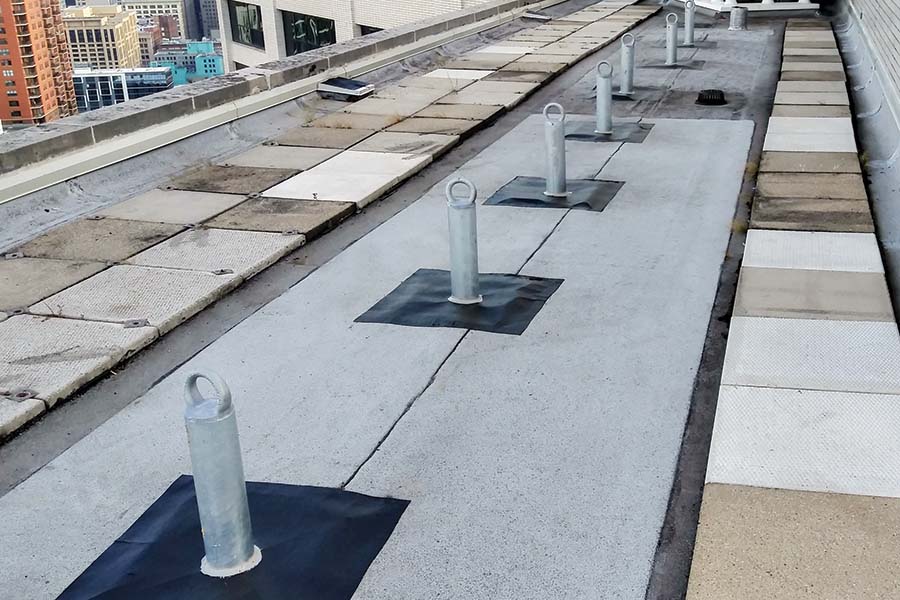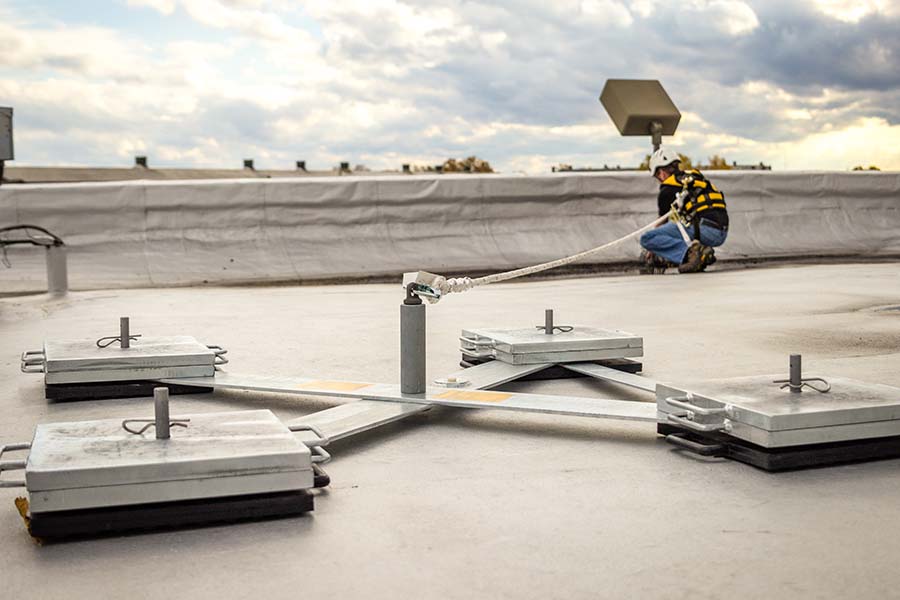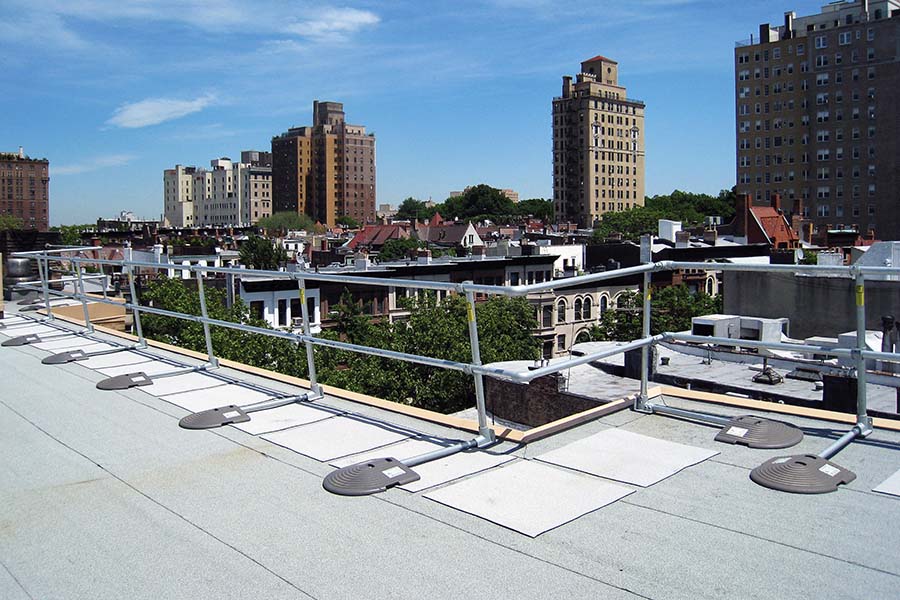Fall Arrest Anchor Point Requirements and the 5,000 lb. Myth

Because of OSHA’s various fall protection anchor point requirements over the years, it’s easy to think that every fall protection anchor point needs to be able to withstand a force of 5,000 lb. But that may not be true.
In this article, I will show you how you can choose a fall arrest anchor point that is compliant with OSHA regulations and that it may not have to withstand a force of 5,000 lb.
What is a “5,000 lb. Anchor Point?”
The first thing I want to clarify is the phrase “5,000 lb. anchor point”. This common vernacular means an anchor that can withstand a force of 5,000 lb. It does not mean an anchor that weighs 5,000 lb.
The Origins of the 5,000 lb. Anchor Point Requirement

Before 2017, OSHA’s General Industry Standards allowed for no option other than a 5,000 lb. anchor.
However, at the same time, OSHA’s Construction Standards allowed for either the use of a 5,000 lb. anchor or a complete fall protection system designed with a safety factor of two.
Because of the discrepancy between general industry and construction standards, many people tried to use the construction standards in general industry applications. This led to confusion and many debates in the safety industry.
Ultimately, it became easier just to believe that all anchors needed to be able to withstand 5,000 lb. of force.
Thus, the myth was born.
What does OSHA actually say about Fall Arrest Anchor Point Requirements?
Fast-forward to 2017, OSHA updated the General Industry standard to make the fall protection requirements clearer and more accessible.
These changes included merging the 5,000 lb. anchor point rule in the General Industry standards and the construction standards, which allowed for a system with a safety factor of at least two.
For reference, here is the code found in 1910.140:
1910.140(c)(13) - Anchorages, except window cleaners' belt anchors covered by paragraph (e) of this section, must be:
1910.140(c)(13)(i) - Capable of supporting at least 5,000 pounds (22.2 kN) for each employee attached; or
1910.140(c)(13)(ii) - Designed, installed, and used, under the supervision of qualified person, as part of a complete personal fall protection system that maintains a safety factor of at least two.
As you can see, OSHA now allows for systems designed with a safety factor of two to be used instead of an anchorage that can support 5,000 lb. of force.
There are three things I want to point out to make sure this is done correctly.
Why is it important that the system be designed, installed, and used under the supervision of a qualified person?
As the regulations clearly state, any system you use needs to be designed, installed, and used under the supervision of a qualified person. This means that you must use a professionally designed system from a fall protection company and that DIY solutions are off the table.
This requirement includes the weights, the pins, and the rubber coatings used on systems to help create the necessary safety factor. Everything must be considered.
I’ve seen installations where someone pours concrete for fall protection in the same configuration as a professionally designed system. It’s assumed that this would work without considering how much testing every single system component endures to create a safe system.
This includes the weights, the pins, and the rubber coatings used on systems to help create the necessary safety factor. Don’t MacGyver a solution that looks just like the real thing. Use the real thing from a fall protection company.
What makes a personal fall protection system “complete”?
It’s important that any system that you use is complete from anchor to the user. OSHA defines a complete personal fall protection system like this:
Personal fall arrest system means a system used to arrest an employee in a fall from a walking-working surface. It consists of a body harness, anchorage, and connector. The means of connection may include a lanyard, deceleration device, lifeline, or a suitable combination of these.
Different professionally designed systems will have requirements for what types of connectors you can use with them. Make sure to pay attention to the manufacturer’s documentation when choosing safety harnesses and safety lanyards, or better yet, consult with a company that specializes in fall protection and can supply you with a complete system out of the box.
Hint, hint, that’s us.
Understanding the Safety Factor of Two
Any system you use needs to be designed to withstand twice the potential impact of a falling worker. This calculation will always be considered by the manufacturer of a personal fall protection system. They will provide a copy of or links to documentation stating that their product meets these requirements and will often include testing information in their documentation.
If a company you are working with cannot provide you with documentation stating that their system meets these requirements, we suggest looking for an alternative supplier immediately.
Personal fall protection systems are safety-critical, and you need to know you’re working with competent safety professionals. Documentation and testing are an integral part of ensuring you are using a quality product you can trust, so if it can’t be provided upon request, I would immediately look for an alternative provider.
What does this mean for You?
Thanks to the 2017 OSHA update, you have clearer options to keep your people safe when working at height, all while staying compliant and meeting OSHA’s requirements. You don’t have to cut open your roof to install a fall protection anchor point, and it doesn’t necessarily have to be able to withstand 5,000 lb. Here is an example of what you could use instead.
An Example of a Compliant Fall Arrest Anchor Point

The Weightanka non-penetrating anchor point can support up to two users in fall restraint and one user in fall arrest. You can move it around your roof, take it with you from job to job, or leave it in place for when it is needed. It is galvanized steel, so you don’t have to worry about it corroding in your first winter or rainstorm.
Consider an Alternative to a Fall Arrest Anchor Point

It’s important to recognize that a fall arrest protection system may not be the best solution. Guardrail systems, like KeeGuard, can provide a passive and non-penetrating solution that doesn’t require constant training or exposure to risk.
You have more options to keep your people safe. If you’re still unsure what solution is best for your team, reach out to one of our fall safety experts.


